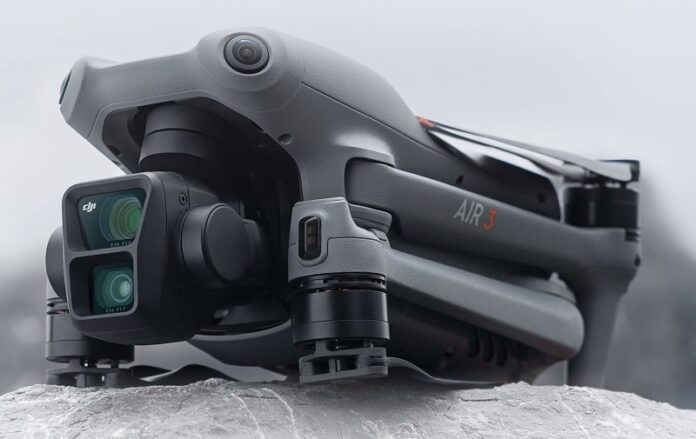When I read the first leaks about the DJI Air 3, I thought that the only improvement from its predecessor would be the dual-camera system. After the official reveling, I realized it is a consumer mass-market drone with some impressive flagship features.
DJI states that the new Air 3 has 48% more battery life than its predecessor. With up to 46 minutes of flight time is truly impressive for its price range. Along with improved battery life comes a new and improved smart charging hub with juice transfer from one battery to another.
Featuring the next-generation O4 transmission system, the DJI Air3 has a range of up to 20 km in FCC mode and 10 km in CE mode. The estimated max flight distance with a charge is about 32km.
Following the lead of high-end drones like the Mavic 3, the DJI Air 3 gets two cameras on a single 3-axis gimbal system. Both cameras have a 1/1.3-inch CMOS image sensor with 48 MP effective pixels. While the wide-angle camera has a FOV of 82° and 24 mm FE, the medium-tele camera has 35° FOV and 70 mm FE. Both cameras can record 4K (3840×2160) videos with up to 100fps or FHD (1920×1080) with up to 200fps for slow-mo footage.
DJI Air 3: Key features
- [Stabilized Dual-Camera System] Air 3 boasts the first dual-primary camera system of the Air series, embedding a 1/1.3-inch-CMOS wide-angle camera and a 1/1.3-inch-CMOS 3x medium tele camera in a sleek and compact body. The two cameras have the same sensor size but different focal lengths, delivering consistent image quality [3] and more dynamic imaging possibilities.
- Wide-Angle Camera
- 2.4μm Pixel Size
- 24mm Format Equivalent
- f/1.7 Aperture
- 3x Medium Tele Camera
- 2.4μm Pixel Size
- 70mm Format Equivalent
- f/2.8 Aperture
- Wide-Angle Camera
- [Extended Flight, Innovative Charging] Air 3 offers up to 46 minutes of flight time, an increase of 48% compared to the previous generation. This provides plenty of time to explore, adjust compositions, and get the shots you want, all during a single flight. The new battery charging hub supports an innovative power transfer function. Press and hold the function button to transfer the remaining power from multiple batteries to the battery with the highest remaining power, giving you a more fully charged battery in situations where charging options are limited.
- [Omnidirectional Obstacle Sensing] An omnidirectional sensing system enables comprehensive environmental awareness, allowing Air3 to detect obstacles in all directions. When obstacles are detected, Air 3 can use APAS 5.0 to perform smoother avoidance movements for a safer overall flight experience. Even complete beginners can fly confidently and execute creative ideas with enhanced safety.
- [O4 HD Video Transmission] The fourth-gen OcusSync HD video transmission system empowers Air 3 with dramatically enhanced transmission performance. It provides a max range of 20 km with increased stability and a 1080p/60fps max-quality live feed to ensure ultra-smooth viewing and operating.
- [Advanced RTH] During Smart Return To Home (RTH), Air 3 will automatically plan an optimized flight route for Advanced RTH while maintaining omnidirectional obstacle sensing to return to its home point quickly and safely.
- [FocusTrack] This autonomous flight feature keeps you or your subject easily in the center of the frame. The 3x medium tele camera unlocks a unique sense of spatial compression when highlighting subjects. This updated tracking performance, combined with omnidirectional obstacle sensing, lets you get intelligent, well-planned shots whenever and wherever you need them.
- [MasterShots and QuickShots] MasterShots allows Air 3 to automatically perform diverse camera movements, shooting multiple clips and editing them with music, cuts, and effects for fast and simplified cinematic footage. QuickShots empower Air 3 with creative camera movement options like Rocket, Dronie, Circle, Helix, Boomerang, and Asteroid.
History of DJI’s Air series
Over the last 6 years, DJI released four models of its Air series. The first generation Mavic Air was a nice drone with limited features and, honestly, an ugly design -even for that time. DJI released the Mavic Air 2 two years later, reviewed here on FirstQuadcopter. The Air 2 was a game-changer in the consumer drone market and was replaced just one year later by the Air 2S. In the summer of 2023, the company released the Air 3, which gets a dual camera, 48% improved flight time, and 20KM range.
- 2018: DJI Mavic Air – take-off weight 430g
- 2020: DJI Mavic Air 2 – take-off weight 570g
- 2021: DJI Air 2S – take-off weight 595g
- 2023: DJI Air 3 – take-off weight 720g
As you can see above, the weight of the DJI Air series increased over time. Luckily the weight of the DJI Air 3 still does not put it in a different category when it comes to UAV regulations -the next threshold being over 900 grams.


Best drone for your money! I’m a big fan of DJI’s Air series.
The Air 3 is the best choice for those who can’t afford the Mavic 3 Pro.
10KM in Europe region (CE), that is pretty impressive.
Looking forward to O4 though!
One 1-inch sensor is much better than two small sensors!